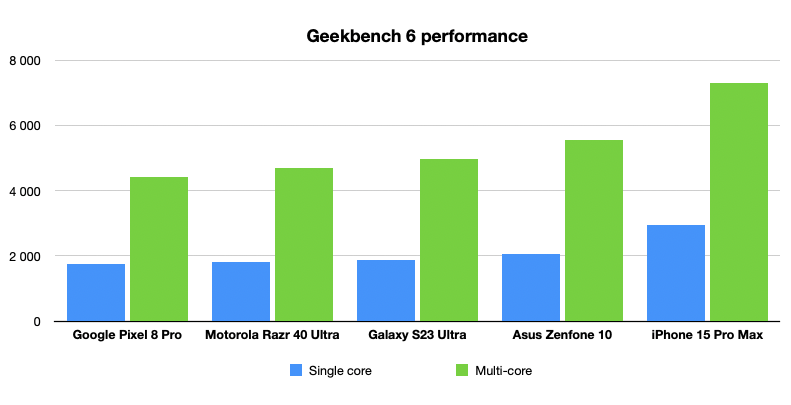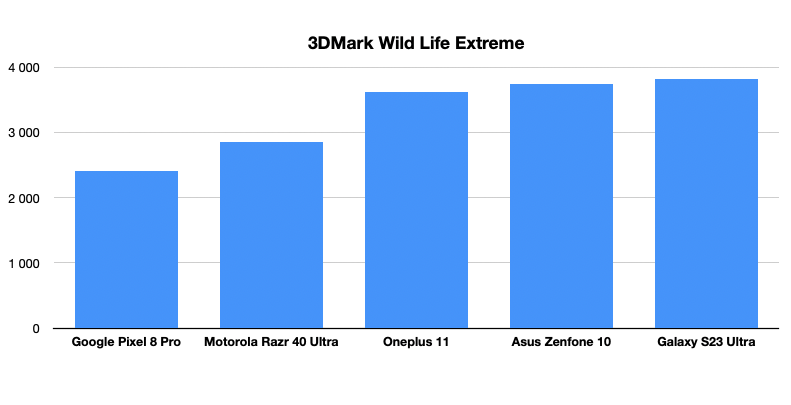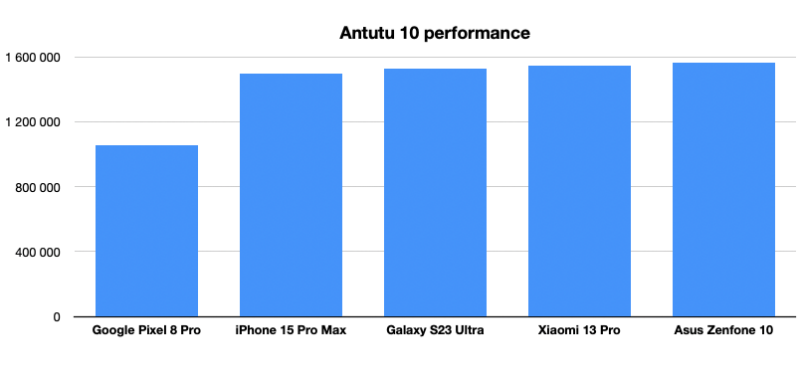After years of looking for Google mobiles that were only launched in other countries, it was finally our turn last year. That’s when the Google Pixel 7 Pro, Pixel 7 and Pixel 7a were released and performed very well in our tests. We also got the Pixel Buds Pro earbuds, but not the Pixel Watch. However, this year’s launch didn’t lack anything. We got the Google Pixel 8 and Pixel 8 Pro, as well as the Pixel Watch. The budget model Pixel 8a will probably be launched in the spring.
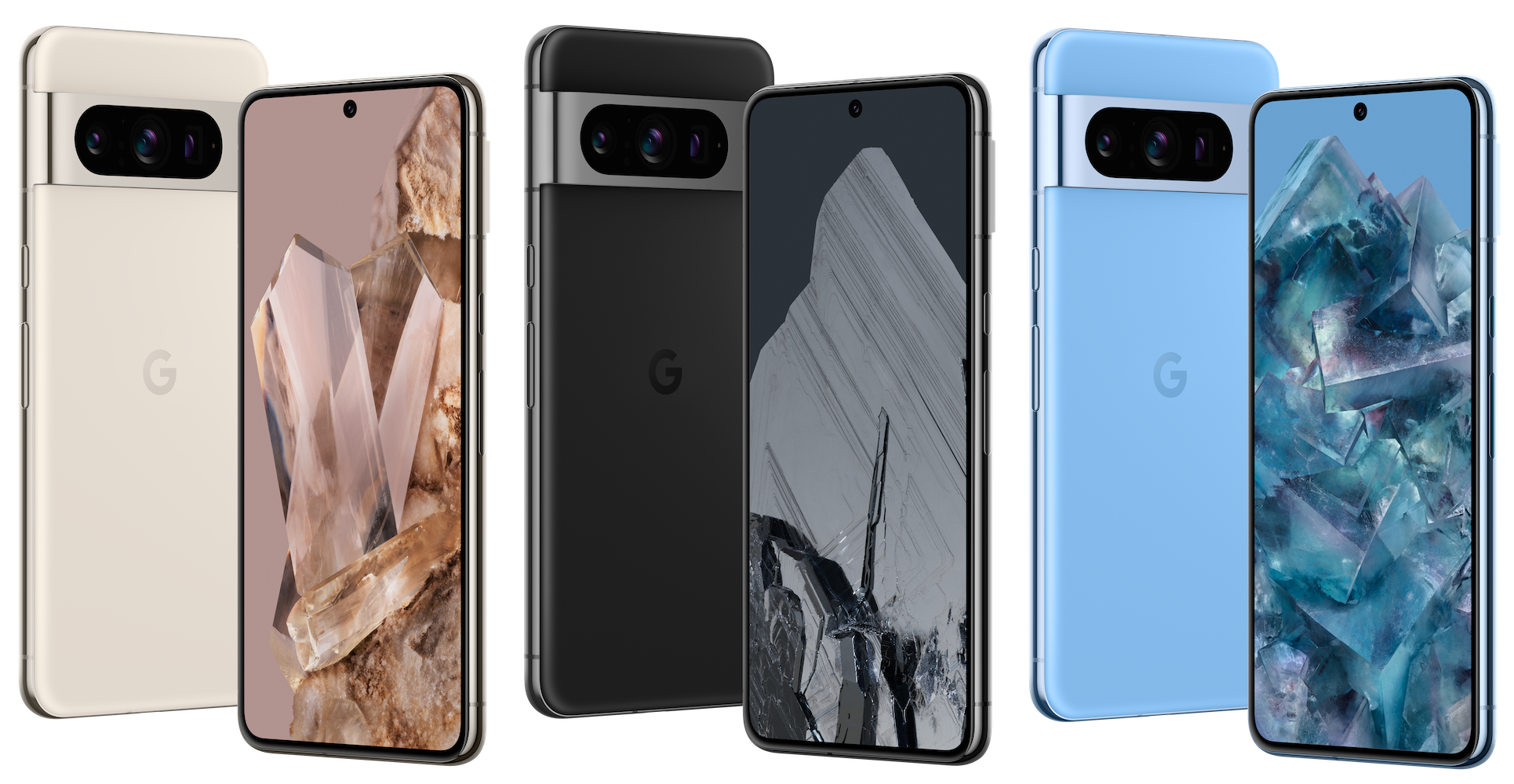
Appearance and construction
It would be wrong to say that the Pixel 8 Pro has been radically redesigned. The three cameras in the slightly elevated camera panel are now hidden behind a common glass. Last year’s upgrade was to make the band metallic, and we like that they’ve kept the metallic stripe as it makes the phone stand out from the crowd. The flash has been moved slightly to make room for the new temperature sensor. The phone is available in black (obsidian), off-white (porcelain) and light blue (bay), which is a bit more cheerful than last year’s muted colours. The back is also made of matte glass (Gorilla Glass Victus), which makes it less slippery. The screen has got Gorilla Glass Victus 2.
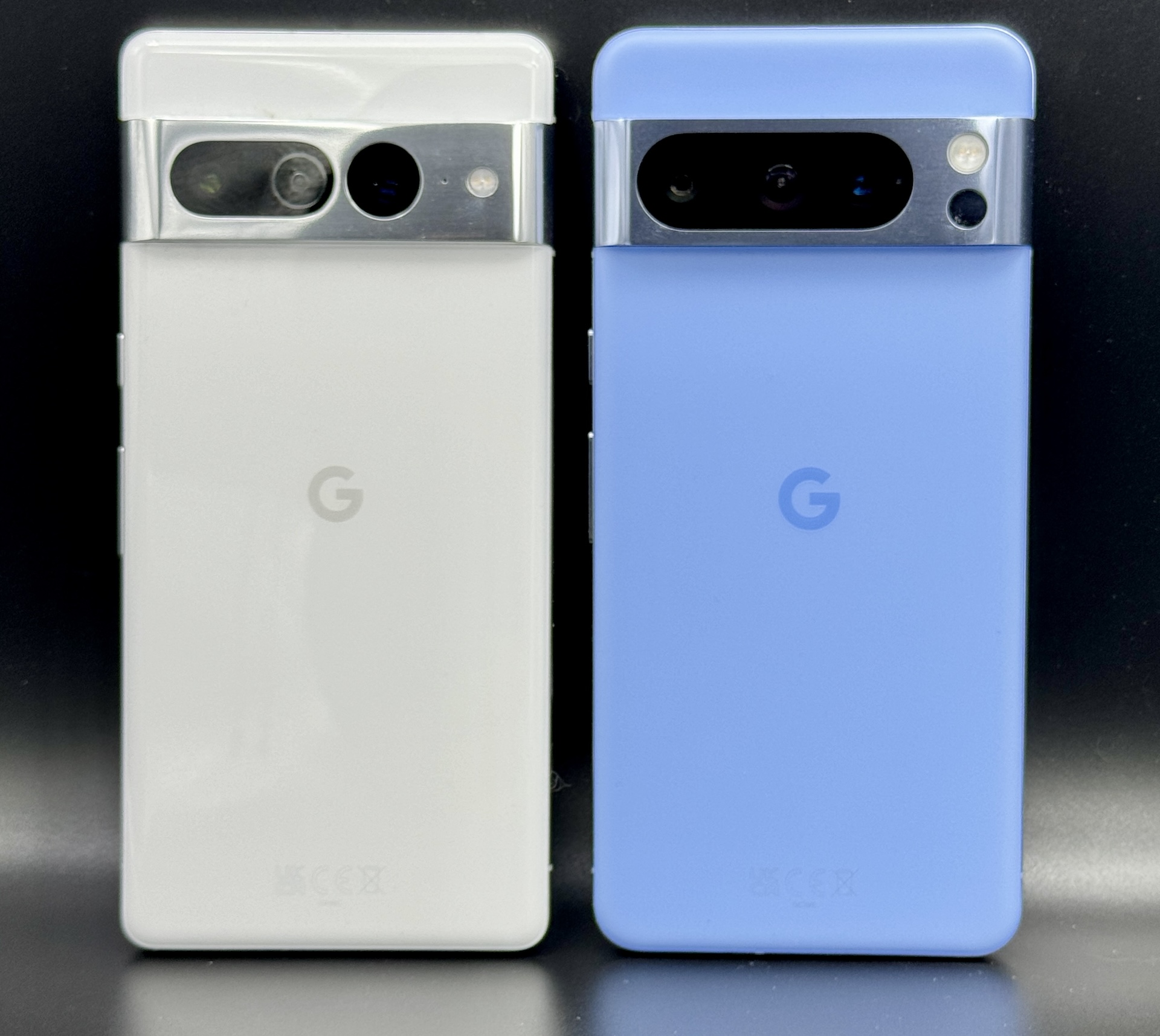
The screen
We get the same large display as last year, but curiously with a slightly lower resolution. The display technology is the same excellent LTPO OLED panel. But the brightness has been pushed up to a whopping 1,600 nits in high brightness mode and with a peak brightness of an impressive 2,400 nits. That’s 60 per cent brighter than last year’s model and 15-20 per cent brighter than the regular Pixel 8. In addition to the display being able to go up to 120 Hz refresh rate to make games run smoothly, it can also go down to just 1 Hz to save power when you’re displaying a static image.
The second generation Google smartwatch was only released in a few European countries. Now you the successor is much more widely available.
Camera upgrades
The cameras have also been upgraded. Some to a lesser extent, such as the main camera, which has only improved light sensitivity by 21 per cent, but is said to have better image quality. The telephoto camera has become 56 per cent more light sensitive. The ultra-wide angle has also been beefed up, which is wise, as it was the weak point of the previous model. It has been upgraded from 12 to now 48 megapixels and has become significantly more sensitive to light, as well as having better autofocus. It also has better macro focus.
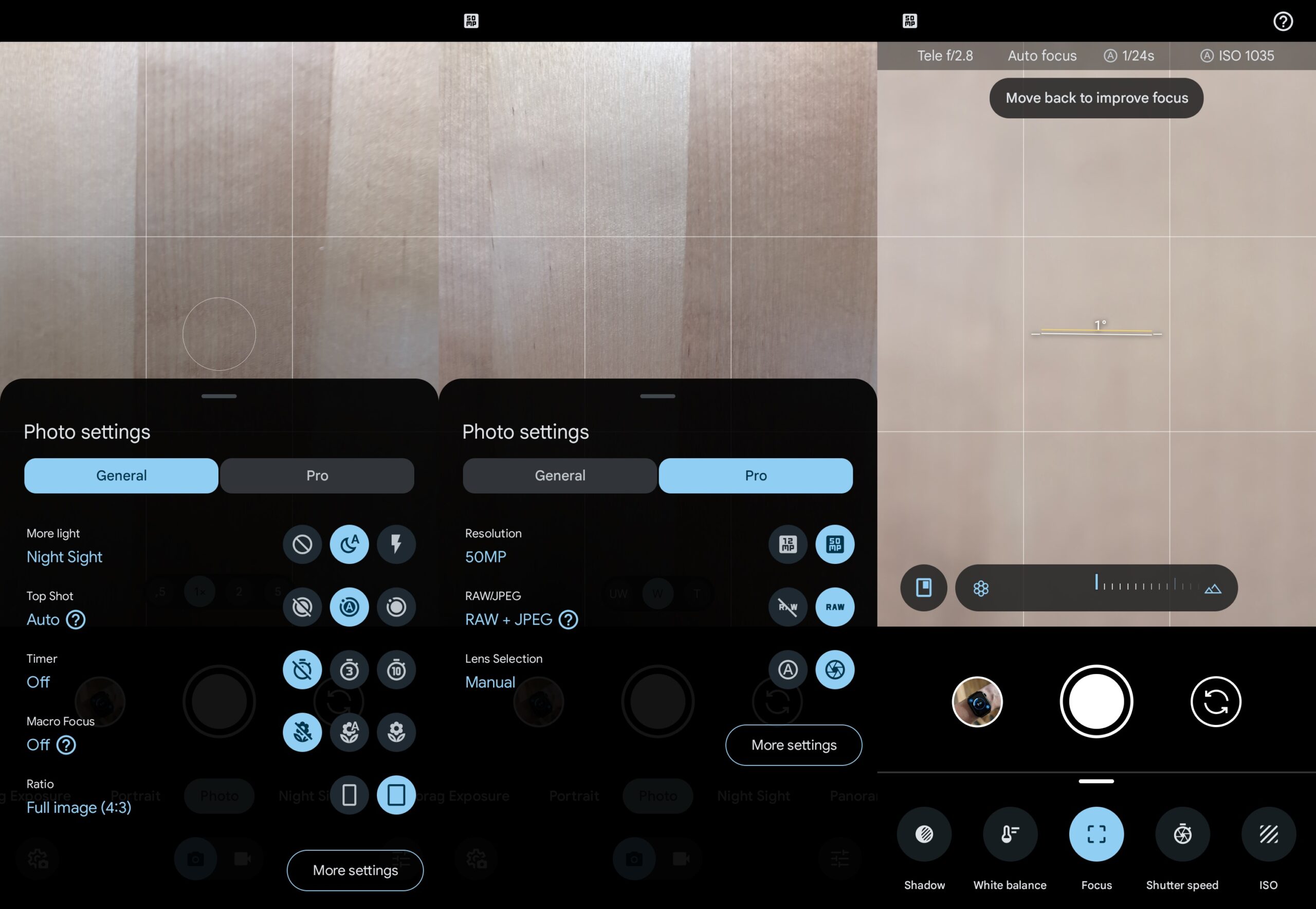
Photo quality hasn’t improved dramatically, except that thanks to the more light intensive optics, night shots have improved slightly. But this should be seen in relation to an already very high level, where we rate the photo quality among the very best mobiles. With the ultra-wide angle, on the other hand, the quality has improved significantly, and with such detail and sharpness, it’s hard to find anything to complain about without being pedantic.
As usual, however, it’s on the software side that Google’s camera shines. The 8 Pro has been given Pro controls, which means you can shoot at full 50 megapixel resolution, save images in RAW format to preserve image information, and have full manual control over focus, white balance, ISO, shutter speed and aperture.
But above all, the editing tools are fantastic. We already had Magic Eraser, where we can remove unwanted details from images. This is complemented by Magic Edit, which can move objects around and change the sky. As well as Best Picture, where by taking many pictures you can replace the head of people with their eyes closed with one where their eyes are open. For video, there’s now Audio Eraser, where you can remove distracting background noise. And coming soon is Videoboost, which brings HDR+ and colour grading to video, as well as dark mode to video.
Usability
Most of the usability improvements in the Pixel 8 Pro are due to the new Android 14. These include a health centre, a smart assistant that learns the user’s habits and preferences, and adaptive charging to save battery life. But it also comes to other manufacturers’ phones, so it wouldn’t be right to emphasise it as a particular advantage of the Pixel 8 Pro.
Pixel 7 Pro is Google's reference phone that shows how Android 13 should be used. And now it's available.
Something we’ve long complained about is the effectiveness of unlocking using facial recognition on Android phones, which lags far behind Apple’s FaceID. Google now says their Face Unlock is so secure that it can be used for banking logins and payments. Hooray! But even though it works faster and more accurately, it still doesn’t work in the dark.
What’s unique, however, is that the Pixel 8 Pro has a temperature sensor. It works just like infrared thermometers, so you simply point it at a surface and press the button. However, these thermometers are big as guns and not particularly cheap, so it’s quite impressive that Google has managed to squeeze the feature into the phone. And as far as we can tell, it works. However, you can’t tell if you have a fever, as only the skin temperature is measured.
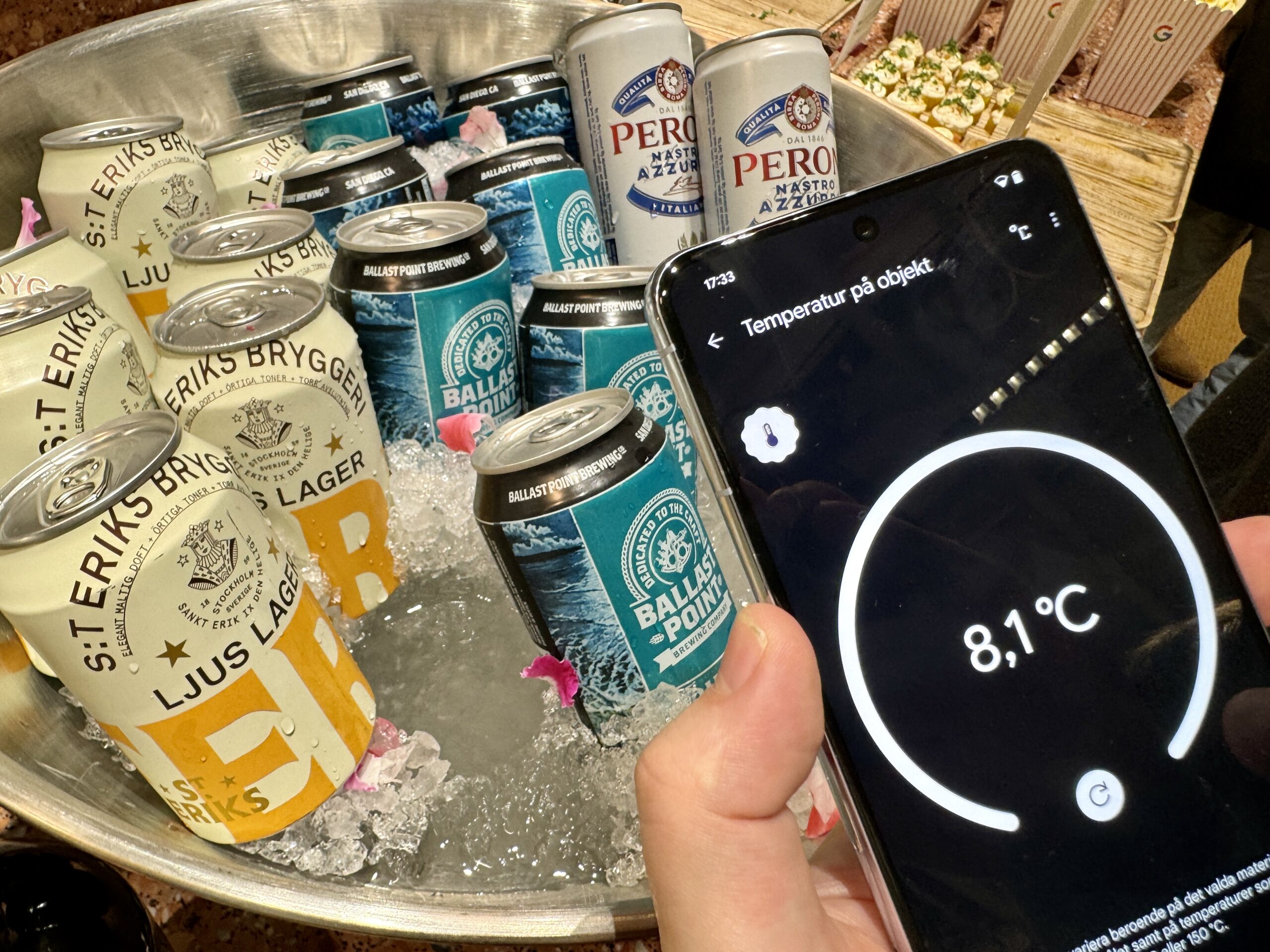
Just point the thermometer at the object you want to measure the temperature of. (Photo: Jonas Ekelund, L&B Home)
In recent years, there has been a lot of talk about products that have to be scrapped prematurely because they are no longer supported. We’re looking at you, Chromebook! Most mobile phone manufacturers only offer three years of updates, which isn’t very long. So we commend Google for offering seven years of Android upgrades, security updates and new features. That means you should be able to keep your Pixel 8 until 2030!
Performance
Under the hood is Google’s own Tensor G3, and need we say it’s the fastest Pixel processor ever, according to Google? The interesting thing about the Samsung-built chip is that it’s not built to break Snapdragon or Apple performance records. It’s designed to deliver amazing AI and machine learning performance to support all those features Google has crammed into the phone.
Compared to the previous model, raw performance, as measured by Geekbench, has increased by 15-20 per cent, which is comparable to the previous performance gains. Graphics performance has increased by an impressive 37 per cent, but it’s from a low level, so we can say it’s starting to catch up with the competition. Overall performance, measured with Antutu 10, tells us that performance has increased by a whopping 29 per cent. But that only brings it up to the level of last year’s Samsung Galaxy S22 Ultra. Compared to this year’s top models, it lags behind, but as mentioned, it’s not supposed to be the fastest either. However, according to Geekbench ML, machine learning performance has improved by a whopping 41 per cent, which Google says is what they’ve been aiming for.
The Pixel 8 Pro has a marginally larger battery, but faster charging. We measured 70 minutes from 10 to 90 per cent charge. PCMark’s battery test gave us 12 hours and 47 minutes, which is among the better results, but without being outstanding in any way.
Conclusion
It’s clear that with its Pixel mobiles, Google wants to set the direction for Android mobiles. And the future is not an arms race on raw speed. Our mobiles are already as fast as computers, but do we really need it? Instead, it makes everything a little smarter. The camera takes better pictures for us, the microphone cancels noise for us, the assistant understands what we want, and it charges the battery smarter than we can figure out on our own. That’s not to say that there are no new features, because the performance has really improved, the screen has become extremely bright – and the phone has a thermometer! Sure, it has its flaws, but you just have to surrender to the feeling of desire.

We think
Extremely bright screen, thermometer(!), vastly improved ultra-wide angle camera, impressive AI photo features, better facial recognition, 7 years of updates. Performance is still on par with last year's competitors.
1099 €
Specifications
- Operating system: Android 14
- Display: 6.7″ LTPO OLED 1,344 x 2,992, 1-120 Hz, 1,600 nits
- Processor: 3.0 GHz Google Tensor G4 (4 nm)
- Memory: 12 GB / 128-512 GB
- Main camera: 50 Mp, 25 mm, f/1.68, 1/1.31″, Laser AF, OIS
- Wide-angle camera: 48 Mp, f/1.95, 126˚ PDAF
- Telephoto camera: 48 Mp, 113 mm, f/2.8, 1/2.55″, OIS, 5x optical zoom
- Selfie camera: 10.5 Mp, 22 mm, f/2.2, 1/3.1″ PDAF
- Wireless: 5G, Wi-Fi 7, BT 5.3 aptX HD, NFC, UWB, 4xGPS
- Dimensions / Weight: 163 x 77 x 8.8 mm / 212 grams
- Battery: 5,050 mAh, 30 W charging, 23 W wireless
- Web: store.google.com
Benchmarks
- Geekbench 6 (single/multi/compute): 1750/4429/5021
- Antutu 9: 828 250
- Antutu 10: 1 053 875
- AItutu: 622 962
- GFXBench T-Rex: 6 710 frames
- 3DMark Wild Life Extreme: 2 413
- Basemark Web: 641,03
- PCMark Work 3.0: 11 149
- PCMark battery: 11:02


